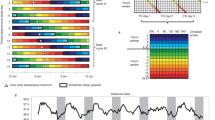Summary
The period of freerunning circadian rhythms is significantly shorter and the fraction of sleep is significantly larger in human females than in males, as long as the rhythms run internally synchronized. The sex difference in the period could be a property either of the whole circadian system or of only one of the oscillators in a multi-oscillator system. The sex difference in the sleep fraction could be a fixed property of the sleep-wake rhythm or could depend on interactions in the multi-oscillator system. To investigate these questions, a sample of 33 long-term experiments, in which the rhythms ran internally synchronized in one section and internally desynchronized in another section, were analyzed. The periods of rhythms in rectal temperature were different in females and males during internal synchronization, but became identical during internal desynchronization. In contrast, sex differences in sleep-wake periods were more pronounced when the rhythms were desynchronized than when they were internally synchronized. This result provides evidence that the sex difference in periodicity is a property only of the sleep-wake rhythm; the intrinsic periods of temperature rhythms are identical in females and males, whereas those of sleep-wake rhythms are distinctly shorter in females than in males. In the state of internal synchronization, the joint period is a compromise between the intrinsic periods of the rhythms involved, and therefore it shows a small but significant sex difference. Moreover, the transition from internally synchronized to desynchronized rhythms is combined with a highly significant reduction in the sleep fraction, which is considerably greater in females than in males. These results suggest that the occurrence of internal desynchronization strongly affects the sleep-wake rhythm, and that the influence of rhythm disorders is considerably greater in females than in males.
Similar content being viewed by others
References
Aschoff, J., Circadian activity rhythms in chaffinches (Fringilla coelebs) under constant conditions. Jap. J. Physiol.16 (1966) 363–370.
Davis, F. C., Darrow, J. M., and Menaker, M., Sex differences in the circadian control of hamster wheel-running activity. Am. J. Physiol.244 (1983) R93-R105.
Wever, R. A., The circadian multi-oscillator system of man. Int. J. Chronobiol.3 (1975) 19–55.
Wever, R. A., The Circadian System of Man. Springer, New York/Heidelberg/Berlin 1979.
Wever, R. A., On varying work-sleep schedules: the biological rhythm perspective, in: Biological Rhythms, Sleep and Shift Work, pp. 35–60. Eds L. C. Johnson, D. I. Tepas, W. P. Colquhoun and M. J. Colligan. Spectrum Publ., New York 1981.
Wever, R. A., Behavioral aspects of circadian rhythmicity, in: Rhythmic Aspects of Behavior, pp. 105–171. Eds F. M. Brown and R. C. Graeber, L. Erlbaum Ass. Inc., Hillsdale N.J. 1982.
Wever, R. A., Properties of human sleep-wake cycles: parameters of internally synchronized freerunning rhythms. Sleep7 (1984) 27–51.
Wirz-Justice, A., Wever, R., and Aschoff, J., Seasonality in freerunning circadian rhythms in man. Naturwissenschaften71 (1984) 316–319.
Author information
Authors and Affiliations
Rights and permissions
About this article
Cite this article
Wever, R.A. Sex differences in human circadian rhythms: Intrinsic periods and sleep fractions. Experientia 40, 1226–1234 (1984). https://doi.org/10.1007/BF01946652
Published:
Issue Date:
DOI: https://doi.org/10.1007/BF01946652




